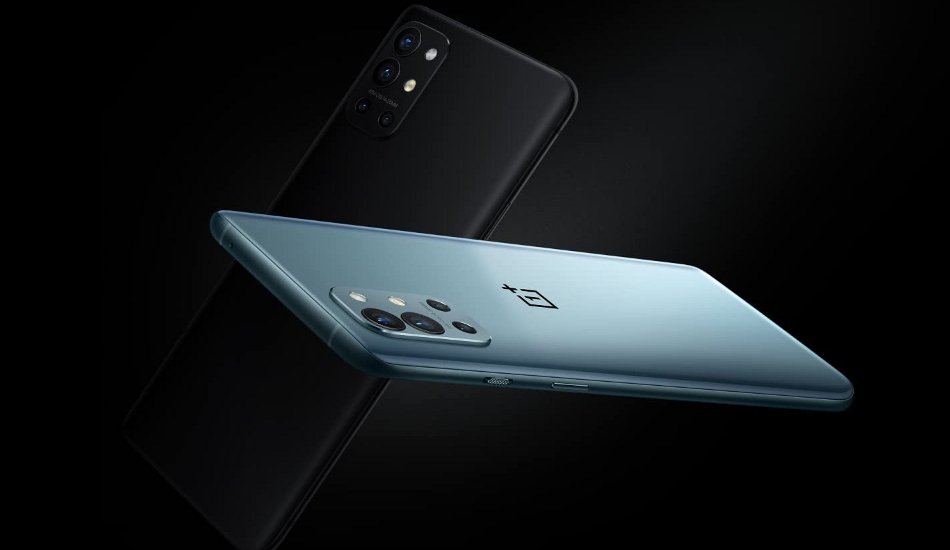We witnessed a bunch of smartphones getting launched in India in March month. The devices ranged from budget phones like Micromax IN 1 to mid-range like Galaxy A52 and Galaxy A72. In the premium segment which launched in the country in March, there were Vivo X60 series and OnePlus 9 as well.
Let’s have a look at the smartphones that launched in India last month along with their specifications and pricing details.
Poco X3 Pro
Poco X3 Pro is priced at Rs 18,999 for the 6GB RAM + 128GB storage model and Rs 20,999 for the 8GB RAM + 256GB storage option. Poco X3 Pro key specifications include a quad rear camera setup, 120Hz refresh rate, 5160mAh battery with Fast charging support, and Snapdragon 860 chipset.
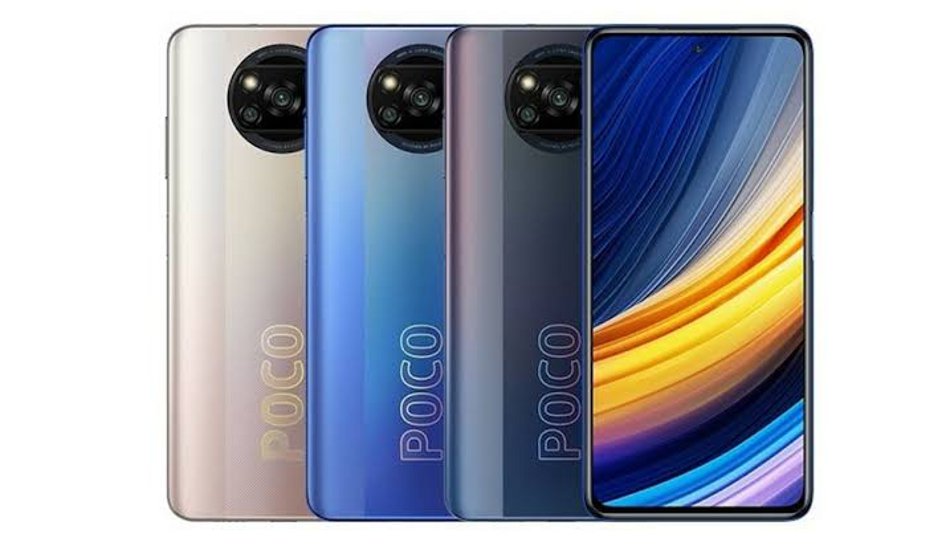
It features a 6.67-inch (1080 x 2400 pixels) LCD display with a 120Hz refresh rate, HDR10, up to 450 nits brightness, 240Hz touch sampling rate and Corning Gorilla 6 protection. There is a 120Hz refresh rate display in the phone but an LCD panel can be a turndown as a lot of users tend to prefer an AMOLED Display over LCD.
It is powered by the new Snapdragon 860 SoC based on a 7nm process paired with Adreno 640 GPU. The phone comes with up to 8GB of RAM and up to 256 GB of storage. The smartphone runs on MIUI 12 based on Android 11. The phone packs a good 5160mAh battery with support for 33W fast-charging which will easily last for two days.
In terms of cameras, the phone comes loaded with a quad-camera setup with a 48-megapixel primary Sony IMX582 sensor with an f/1.79 aperture, an 8-megapixel ultra-wide-angle shooter with a 119-degree field of view and an f/2.2 aperture, a 2-megapixel macro shooter, and a 2-megapixel depth sensor. For the front, there is a 20-megapixel sensor with f/2.2 aperture.
Poco X3 Pro Pros
Excellent battery life, fast charging
Large screen with 120Hz refresh
IP53, dust and splash protection
Powerful chipset
Poco X3 Pro Cons
Quite Bulky and heavy: 213 grams and 9.4mm thickness
No 5G Support
Plastic Build
Realme 8 series
Realme 8 series was launched by the company with Realme 8, as well as the Realme 8 Pro smartphones. The Realme 8 is powered by the MediaTek Helio G95 chip while the Pro is more of a mid-ranger, powered by the Qualcomm Snapdragon 720G chip. Realme 8 is a lower powered model out of the two.
Realme 8 Pro comes in two variants and is priced at Rs 17,999 for the 6GB + 128GB variant while it’s Rs 19,999 for the 8GB + 128GB variant. Realme 8 comes in three variants with 4GB + 128GB model priced at Rs 14,999, 6GB + 128GB model priced at Rs 15,999 and the top-end model with 8GB RAM and 128GB of storage is priced at Rs 16,999.
Realme created a lot of hype with its 108-megapixel f/1.88 Samsung ISOCELL HM2 primary sensor in Realme 8 Pro. It is the same sensor which Xiaomi has used on its Redmi Note 10 Pro Max which offers much better specifications overall at the same price.
Realme 8 Pro features a 6.4-inch full HD+ Super AMOLED display with a Resolution of 1080 x 2400 pixels, 60Hz of refresh rate and 1000-nits peak brightness. Notably, Xiaomi is offering a 120Hz Amoled display at a much lesser price on its Redmi Note 10 Pro, as well as the Redmi Note 10 Pro Max.
The phone is powered by a 2.2GHz Snapdragon 720G processor. Realme has been using the same Chipset for the past 2 years. Realme 8 Pro’s predecessor, which was the Realme 7 Pro, and its predecessor as well, the Realme 6 Pro, uses the same chipset and there’s no upgrade in this. It packs a battery capacity of 4500mAh with 50W fast charging support. It runs Android 11 with Realme UI 2.0 and features an in-display fingerprint scanner.
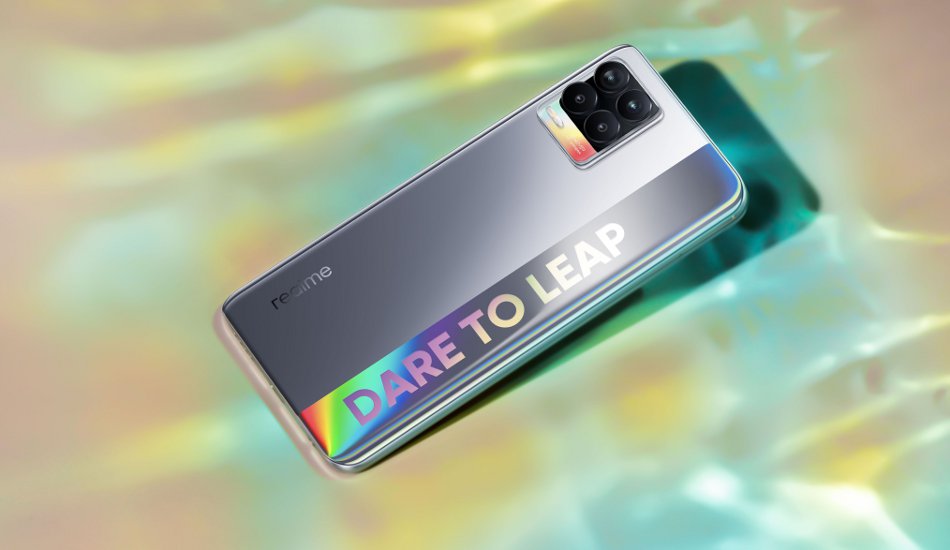
For the camera, the Realme 8 Pro has a quad-camera setup with a combination of a 108-megapixel f/1.88 Samsung ISOCELL HM2 primary sensor, an 8-megapixel sensor with an ultra-wide-angle f/2.25 lens and 119-degree field-of-view (FoV), a 2-megapixel macro shooter with f/2.4 aperture, and a 2-megapixel black and white sensor with an f/2.4 aperture. On the front, there is a 16-megapixel Sony IMX471 sensor with an f/2.45 Aperture lens housed in a hole-punch cutout that can be used for selfies.
Realme 8 ships with a 6.4-inch full HD+ Super AMOLED display with a resolution of 1080 x 2400 pixels. It is powered by the octa-core MediaTek Helio G95 SoC. It has a larger battery than the Pro model, at 5,000mAh with support for slower 30W Dart Charge fast charging and the supported charger is included in the box. This phone also runs on Realme UI 2.0 based on Android 11.
For the optics, it has a 64MP primary sensor, an 8MP ultra-wide-angle lens, a 2MP macro lens, and a 2MP B&W lens. On the front, there is a 16-megapixel Sony IMX471 sensor.
Realme 8 Pros
Good AMOLED Display
Lightweight and Slim at 177g and 7.99mm thickness
Big battery
Great gaming chipset
Realme 8 Cons
Bit overpriced
Big branding at the back panel
No High Refresh rate
No 5G support in Realme 8 Pro
Vivo X60 Series
Vivo X60 series of smartphones with Vivo X60, Vivo X60 Pro and Vivo X60 Pro+ were launched in India last month. The most premium smartphone in the series, Vivo X60 Pro+, comes with Qualcomm Snapdragon 888 Processor while the Vivo X60, Vivo X60 Pro are powered by the Qualcomm Snapdragon 870 SoC. They all come with an in-display fingerprint sensor, Android 11, 32-megapixel selfie camera, 6.56-inch Full HD+ display and more.
Vivo X60 is priced at Rs 37,990 and Rs 41,990 for 8 GB RAM + 128 GB storage and 12 GB RAM + 256 GB storage models respectively. The Vivo X60 Pro comes in a single variant with 12 GB RAM + 256 GB storage priced at Rs 49,990. Vivo X60 Pro+ also comes in a single variant with 12 GB RAM + 256 GB storage priced at Rs 69,990.
Vivo X60 Pro+ sports a 6.56-inch Full HD+ 19.8:9 E3 AMOLED display with a resolution of 2376 x 1080 pixels, HDR10+ support, 120Hz refresh rate. It is powered by Snapdragon 888 5nm processor. The phone packs a 4,200mAh battery that supports 55W fast charging and it runs on Vivo’s newest OriginOS 1.0 based on Android 11.
The Vivo X60 Pro+ packs four rear cameras with a combination of a 50-megapixel primary sensor with an f/1.57 lens, a 48-megapixel ultra-wide-angle shooter, a 32-megapixel portrait sensor, and an 8-megapixel periscope shooter. There is also a 32-megapixel selfie camera at the front.
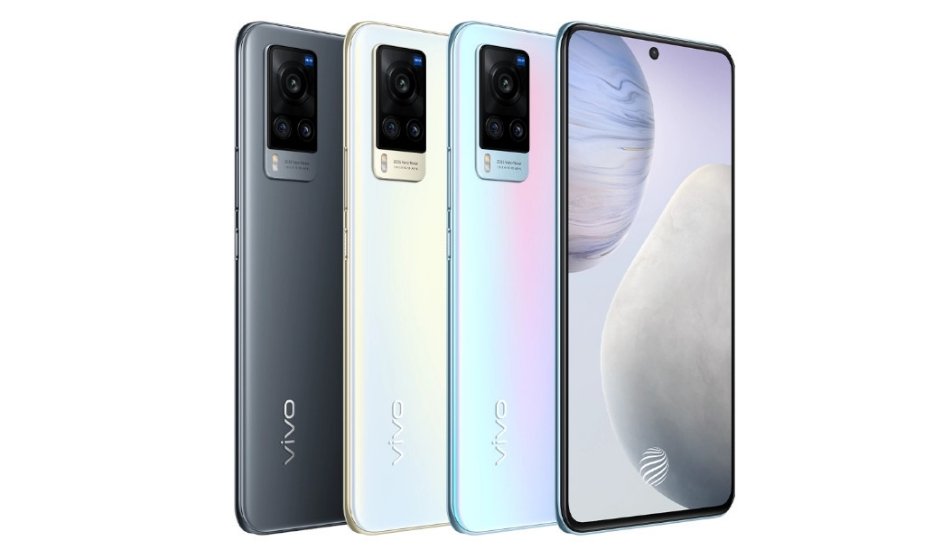
Vivo X60 sports a 6.56-inch E3 AMOLED display with a resolution of 2376 x 1080 pixels, AMOLED display, a 19.8:9 aspect ratio and 120Hz refresh rate. The device is powered by the Qualcomm Snapdragon 870 processor. It is backed by a 4300mAh battery with 33W flash charge support and runs on Vivo’s newest OriginOS 1.0 based on Android 11.
The Vivo X60 packs triple rear cameras with a 48-megapixel primary sensor with an f/1.48 lens, a 13-megapixel secondary sensor, and a 13-megapixel tertiary sensor. For selfies and video chats, there is a 32-megapixel camera at the front, with an f/2.45 lens.
Vivo X60 Pro sports 6.56-inch E3 AMOLED display with a resolution of 2376 x 1080 pixels, HDR10+ support, 120Hz refresh rate and 240Hz touch response. It packs a 4200mAh battery with 33W flash charge support and runs OriginOS 1.0 based on Android 11.
The device is powered by Qualcomm Snapdragon 870 processor paired with 12GB of RAM and 256GB of storage. It has triple camera with 48-megapixel primary sensor with an f/1.48 lens, a 13-megapixel secondary sensor, and a 13-megapixel tertiary sensor. For the front, there is a 32-megapixel camera with an f/2.45 lens.
Vivo X60 Pro Pros
AMOLED screen with 120Hz refresh rate
Premium look and design
Fast performance
Vivo X60 Pro Cons
Less Battery Capacity
No IP rating
OnePlus 9 Series
The highlight of March month was the launch of much anticipated OnePlus 9 series smartphones – OnePlus 9, OnePlus 9 Pro and OnePlus 9R. The new OnePlus flagships come with cameras powered by Swedish brand Hasselblad and are powered by Qualcomm Snapdragon 888. OnePlus 9 and OnePlus 9 Pro both come with 120Hz displays, though the Pro variant offers dynamic refresh rates through its Smart 120Hz feature.
OnePlus 9 is priced at Rs 49,999 for the 8GB + 128GB storage variant, while the 12GB + 256GB storage model is priced at Rs 54,999. OnePlus 9 Pro, on the other hand, comes with a price tag of Rs 64,999 for the 8GB + 128GB storage variant and Rs 69,999 for the 12GB + 256GB storage model. The OnePlus 9R is the cheapest of the three and is priced at Rs 39,999 for the 8GB RAM + 128GB storage variant and Rs 43,999 for the 12GB RAM + 256GB storage variant.
The OnePlus 9 Pro is powered by the Snapdragon 888 processor and sports a 6.7-inch curved QHD+ (3216 × 1440 pixels) LTPO OLED display with an adaptive refresh rate of 120Hz. The SoC is paired with 8GB or 12GB of LPDDR5 RAM and 128GB or 256GB of UFS 3.1 storage. It is backed by a 4500mAh battery with 65W Warp charging support
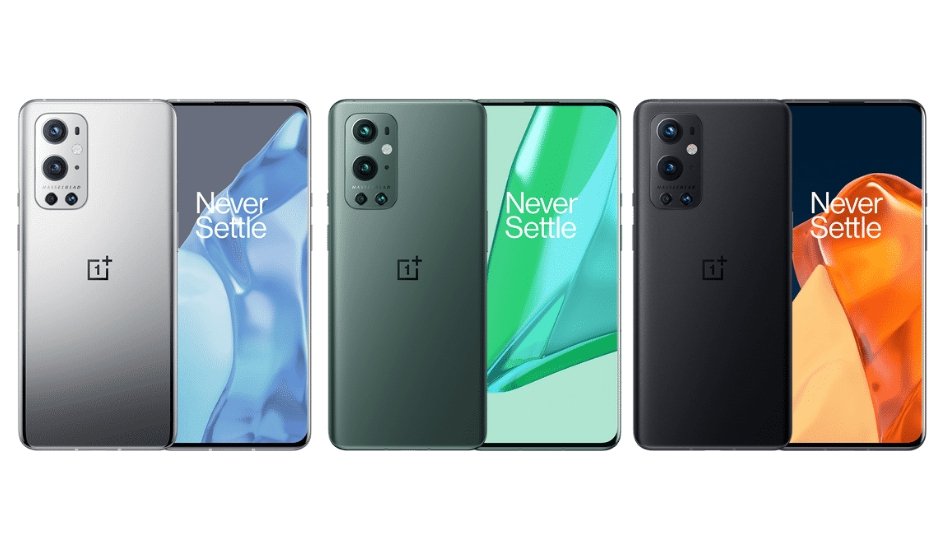
The smartphone runs on OxygenOS 11 based on Android 11 out of the box. For the optics, there is a Hasselblad-tuned quad-camera setup on the back with a 48-megapixel Sony IMX789 f/1.8 main camera with OIS, a 50-megapixel f/2.2 IMX766 ultra-wide angle camera, an 8-megapixel f/2.4 telephoto camera, and another 2-megapixel Monochrome sensor. The phone also includes a 16-megapixel sensor at the front.
OnePlus 9 features a smaller 6.55-inch Fluid OLED display with 120Hz refresh rate, HDR 10+ certification, 1100 nits of peak brightness and is powered by the same Snapdragon 888 SoC as the Pro variant. It is backed by a similar 4500mAh battery with 65W fast charging support and 15W fast wireless charging support and it runs on OxygenOS 11
It sports a triple camera setup at the back with a 48-megapixel f/1.8 IMX689 primary sensor, a 50-megapixel f/2.2 IMX766 ultra-wide-angle sensor, and a 2-megapixel mono sensor. On the front, there is a 16MP shooter. The cameras on the back are tuned by Hasselblad.
OnePlus 9R sports a 6.5-inch Flexible OLED display with a resolution of 1080 x 2400 pixels, a refresh rate of 120Hz, and a touch sampling rate of 240Hz. It is powered by the Snapdragon 870 SoC. It packs a 4,500mAh that supports 65W Warp Charging. It also runs on Android 11 with OxygenOS 11 on top
The OnePlus 9R features a quad-rear camera setup with a 48-megapixel IMX586 main sensor with f/1.7 aperture, a 16-megapixel f/2.2 ultra-wide camera with 123 FoV, a 5MP Macro lens as well as a 2MP monochrome sensor. On the front, there is a 16MP camera for selfies.
OnePlus 9 Pro Pros
120Hz AMOLED display
Excellent performance
Fast charging
OnePlus 9 Pro Cons
Lack of telephoto camera
Decent Battery Life
Micromax IN 1
Micromax also launched its new Micromax IN 1 in India last mont at a price starting from Rs 9,999. The phone features a punch-hole display on the front and a metallic finish with an X pattern on the back. It has triple rear camera setup, 6.67-inch display, 5,000mAh battery and more. Micromax In 1 also comes with L1 Widevine support so one can play HD content on Netflix, Prime Video, and other OTT platforms.
There are two variants of the Micromax In 1 – 4GB of RAM and 64GB of storage and 6GB of RAM and 128GB of storage priced at Rs 10,499 and Rs 11,999 respectively.
Micromax In 1 runs Android 10 out of the box and said to be upgradeable to Android 11 in May this year. Micromax says it will release updates for two years with monthly security updates. The phone runs Stock Android which means there’s no bloatware, no ads.
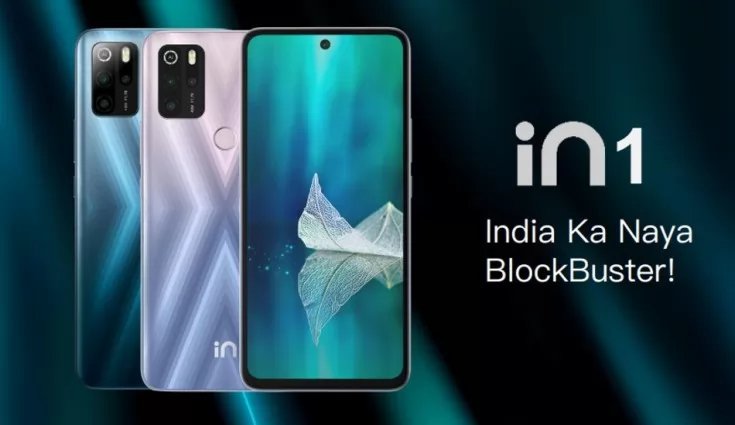
Micromax In 1 packs a 5,000mAh battery with 18W fast charging. The company claims to offer 180 hrs of music streaming, 24 hrs of web browsing and 18 hrs of video streaming. It features a 6.67-inch Full HD+ display with a resolution of 1080 x 2460 pixels, 20:9 aspect ratio.
There is a triple rear camera setup that includes a 48-megapixel primary sensor with an f/1.79 lens, a 2-megapixel sensor for depth of field, and a 2-megapixel macro camera. On the front, there is an 8-megapixel selfie camera.
Micromax IN 1 Pros
Big Battery
Big Screen
Decent Cameras
Micromax IN 1 Cons
Older Android OS
Quality issue with buttons
Samsung Galaxy A52 and Galaxy A72
Samsung Galaxy A52 and Galaxy A72 were also launched in India as nid segment phones. The key features include a 90Hz display, stereo speakers with Dolby Atmos support, IP67 rating for dust and water resistance and an in-display fingerprint sensor.
Samsung Galaxy A52 is priced at Rs 26,499 for the base 6GB RAM + 128GB storage variant and Rs 27,999 for the 8GB RAM + 128GB storage option. The Samsung Galaxy A72 is priced at Rs 34,999 for the 8GB RAM + 128GB storage variant, while its 8GB RAM + 256GB model is priced at Rs 37,999.
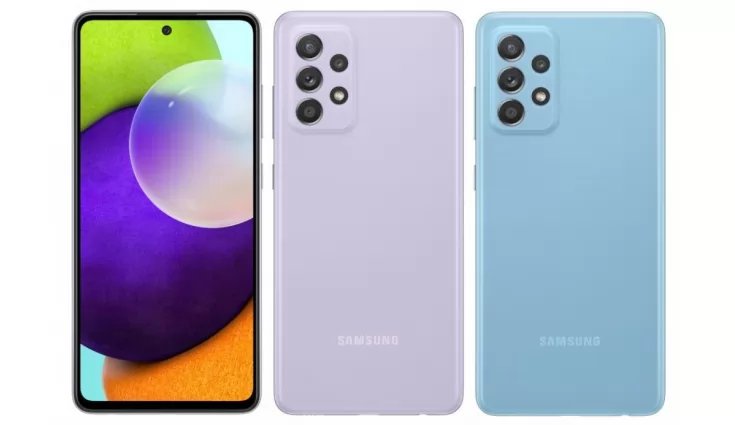
The Galaxy A52 has a 6.5-inch Super AMOLED display with a 90Hz refresh rate. It has an octa-core Qualcomm Snapdragon 720G SoC. It is backed by a 4500mAh battery with support for 25W fast charging and runs on OneUI 3.1 based on Android 11 out-of-the-box
There is a quad rear camera setup with a 64-megapixel primary sensor with an f/1.8 lens and optical image stabilisation (OIS), along with a 12-megapixel secondary sensor with an f/2.2 ultra-wide-angle lens, 5-megapixel depth sensor, and a 5-megapixel sensor with a macro lens. There is a 32-megapixel camera sensor at the front.
Galaxy A72 features a 6.7-inch full-HD+ Super AMOLED Infinity-O Display with 90Hz refresh rate. It is powered by an octa-core Snapdragon 720G SoC. The smartphone is backed by a bigger 5,000mAh battery with 25W fast charging support and runs on One UI 3.1 based on Android 11.
For the camera, there is a 64-megapixel primary sensor with an f/1.8 lens, along with a 12-megapixel ultra-wide-angle shooter, a 5-megapixel macro shooter, and an 8-megapixel telephoto shooter to offer 3x optical zoom. There’s a 32MP f/2.2 front facing camera housed inside a centered punch-hole.
Samsung Galaxy A52 and Galaxy A72 Pros
Super AMOLED Infinity-O Display with 90Hz refresh rate
Big Battery
Samsung Galaxy A52 and Galaxy A72 Cons
Standard design
Older Chipset
Asus ROG Phone 5
ROG Phone 5, ROG Phone 5 Pro, and the ROG Phone 5 Ultimate (Limited) gaming smartphone series was launched in India last month. The key features of the smartphones include 144Hz Samsung AMOLED display, Qualcomm Snapdragon 888 SoC, up to 18GB of RAM, and a 6,000 mAh battery. The ROG Phone 5 Pro comes with ROG Vision Color PMOLED display and the ROG Phone 5 Ultimate version comes with ROG Vision monochrome PMOLED display.
Asus ROG Phone 5 is priced at Rs 49999 for the base model with 8GB of RAM and 128GB storage. The 12GB of RAM and 256GB storage variant is priced at Rs 57,999. The ROG Phone 5 Pro with 16GB of RAM and 512GB storage costs Rs 69,999 and the ROG Phone 5 Ultimate with 18GB of RAM and 512GB storage costs Rs 79,999.
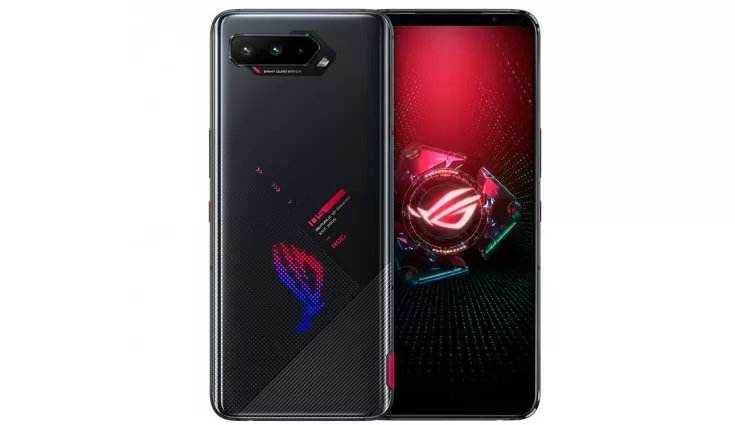
ROG Phone 5 comes with GameCool 5 cooling system, AirTrigger 5, dual front-firing speakers, multi-antenna Wi-Fi, and quad-mic noise-cancelling array
Asus ROG Phone 5 comes with 6.78 inches full-HD+ OLED screen with 1080 x 2448 pixels resolution, an aspect ratio of 20.4:9, 144Hz refresh rate. The phone is powered by an octa-core Snapdragon 888 SoC processor. It sports a 6000mAh battery with 65W HyperCharge fast charging that can charge up to 4200mAh (70%) in 30 minutes and 100% in 52 minutes.
On the camera front, the ROG Phone 5 gaming phone sports a triple rear camera setup, comprising a 64-megapixel primary sensor, a 13-megapixel ultra-wide lens, and a 5-megapixel macro camera. On the front, there is a 24-megapixel selfie snapper. The phone runs Android 11 operating system with ROG UI out-of-the-box.
Asus ROG Phone 5 Pros
Built-in gaming features
Big Screen
Latest OS
Massive Battery
Asus ROG Phone 5 Cons
No telephoto lens
Bulky and heavy
Samsung Galaxy M12
Samsung launched its Samsung Galaxy M12 in India with a massive 6,000 mAh battery, a 6.5-inch display with 90Hz refresh rate, Exynos 850 SoC and 48MP quad rear cameras.
Samsung Galaxy M12 is priced at Rs 10,999 for the 4GB RAM with 64GB storage version and Rs 13,499 for the 6GB RAM with 128GB storage version.
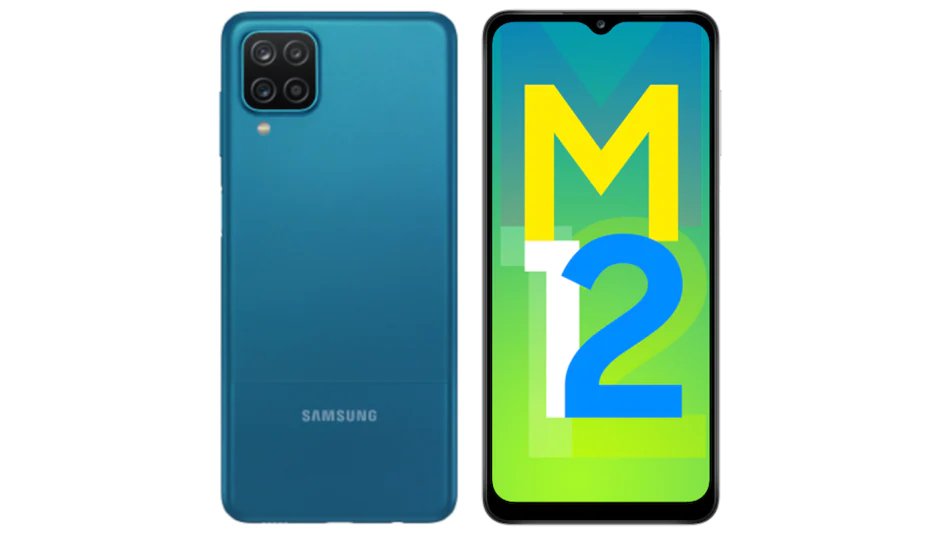
Samsung Galaxy M12 features a 6.5-inch HD+ (720×1,600 pixels) TFT Infinity-V Display with a 20:9 aspect ratio and a 90Hz refresh rate. It is powered by the Exynos 850 SoC, paired with up to 6GB RAM.
There is a quad-camera setup with a combination of a 48-megapixel primary lens with f/2.0 aperture, a 5-megapixel ultra-wide-angle lens with f/2.2 aperture, a 2-megapixel depth sensor and a 2-megapixel macro camera with f/2.4 aperture. For the front, there is an 8-megapixel selfie shooter with f/2.2 aperture.
It packs a 6000mAh battery with support for 15W Adaptive fast charging. The phone runs on Android 11 operating system with OneUI 3.0 running on top of it.
Samsung Galaxy M12 Pros
Great battery life
Comes with Android 11
Samsung Galaxy M12 Cons
Standard design
Redmi Note 10 Series
Xiaomi India launched its Redmi Note 10 series in India that includes the Redmi Note 10, Redmi Note 10 Pro, and the Redmi Note 10 Pro Max. They come with impressive specifications like Super AMOLED display, quad rear camera setups, 33W fast charging and more.
The Redmi Note 10 is the cheapest in the Note 10 series series. It comes with a 60Hz refresh rate and a 48-megapixel primary camera sensor. To compare, the Redmi Note 10 Pro and Redmi Note 10 Pro Max both offer 120Hz refresh rate displays, Android 11-based MIUI 12 and come with up to a 108-megapixel primary camera.
Redmi Note 10 Pro Max is priced at Rs 18,999 for 6GB + 64GB variant, Rs 19,999 for the 6GB + 128GB and Rs 21,999 for the 8GB + 128GB variant. The Redmi Note 10 Pro is priced at Rs 15,999 for 6GB + 64GB variant, Rs 16,998 for the 6GB + 128GB variant and Rs 18,999 for the 8GB + 128GB variant. The Redmi Note 10 is priced at Rs 11,999 for the 4GB + 64GB variant, and Rs 13,999 for the 6GB + 128GB variant.
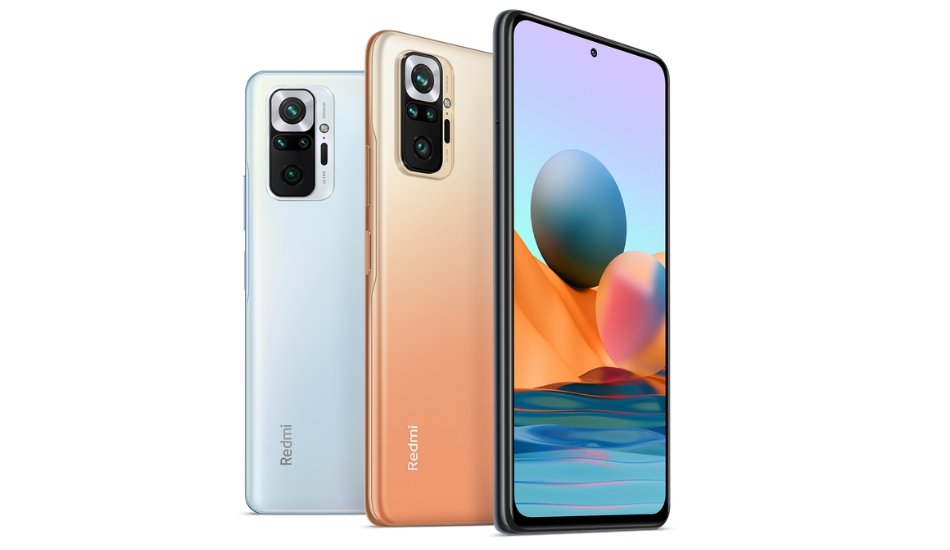
Redmi Note 10 Pro and Redmi Note 10 Pro Max carry the same specifications except the primary rear camera. Redmi Note 10 Pro Max comes with 108-megapixel primary Samsung HM2 camera sensor as compared to 64-megapixel camera in Redmi Note 10 Pro. Redmi Note 10 Pro features a 64-megapixel primary Samsung ISOCELL GW3 sensor, a 5-megapixel super macro shooter with 2x zoom, an 8-megapixel ultra-wide-angle shooter, and a 2-megapixel depth sensor. The Pro Max variant features a 108-megapixel Samsung HM2 camera sensor and the other three remain the same.
Both come with 5,020mAh batteries that also support 33W fast charging. They feature 6.67-inch full-HD+ Super AMOLED displays with 120Hz refresh rate. Redmi Note 10 Pro and Redmi Note 10 Pro Max are powered by octa-core Qualcomm Snapdragon 732G SoC.
Redmi Note 10 features a 6.43-inch full-HD+ (1,080×2,400 pixels) Super AMOLED display. It is powered by the octa-core Qualcomm Snapdragon 678 SoC with Adreno 612 GPU and up to 6GB of LPDDR4x RAM. There is quad rear camera setup on Redmi Note 10 includes a 48-megapixel primary Sony IMX582 sensor, an 8-megapixel ultra-wide-angle shooter, a 2-megapixel macro shooter, and a 2-megapixel depth sensor. The phone comes with a 13-megapixel selfie camera sensor at the front. It has a 5,000mAh battery that supports 33W fast charging.
Redmi Note 10 Pro Pros
Great battery life
Comes with Android 11
Super AMOLED display
Fast Charging
Redmi Note 10 Pro Cons
Lacks 5G support
Oppo F19 Pro, F19 Pro+
Oppo F19 Pro+ and Oppo F19 Pro were launched in India last month. The new Oppo F19 Pro series phones come with Super AMOLED displays with 60Hz refresh rate, quad rear cameras and Android 11 out-of-the-box. In the series, the Oppo F19 Pro+ supports 5G connectivity and is powered by MediaTek Dimensity 800U while the Oppo F19 Pro, on the other hand, comes with 4G support and has older MediaTek Helio P95.
Oppo F19 Pro 8GB + 128GB is priced at Rs 21,490 while the 8GB + 256GB storage is priced at Rs 23,490. The Oppo F19 Pro+ 5G is priced at Rs 25,990 for the single 8GB of RAM and 128GB of internal storage.
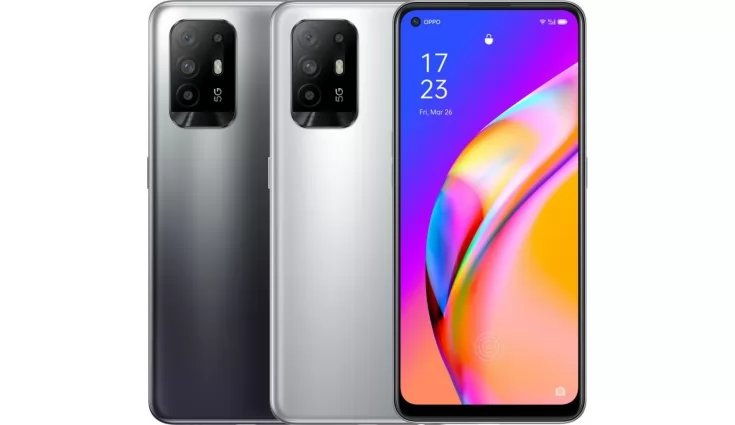
Oppo F19 Pro and F19 Pro+ come with a 6.43-inch Super AMOLED display with a Full HD+ resolution and 60Hz refresh rate. They pack a 4,310mAh battery. Oppo F19 Pro+ comes with 50W fast charging while Oppo F19 Pro comes with 30W fast charging.
For the camera, the Oppo F19 Pro comes with a quad rear camera setup with 48-megapixel primary sensor with an f/1.7 lens, 8-megapixel Wide-Angle macro shooter, 2-megapixel portrait sensor, and a 2-megapixel macro shooter.
The Oppo F19 Pro also features a quad rear camera setup with a combination of a 48-megapixel primary sensor, an 8-megapixel ultra-wide-angle sensor, a 2-megapixel portrait sensor, and a 2-megapixel macro shooter. For selfies, both have a 16-megapixel front camera with an f/2.4 aperture.
Oppo F19 Pro+ Pros
50W fast charging support
5G support
Android 11
Oppo F19 Pro+ Cons
Less refresh rate
Moto G30, Moto G10 Power
Moto G30 and Moto G10 Power were also launched in India last month as the two new smartphones by Motorola. Both Motorola phones come with a waterdrop-style display notch and run on Android 11 with a near stock interface.
Motorola has also equipped its Proprietary ThinkShield for Mobile technology in both phones that provides four layers of enhanced protection to users in terms of protecting personal data from malware, phishing, and other threats.
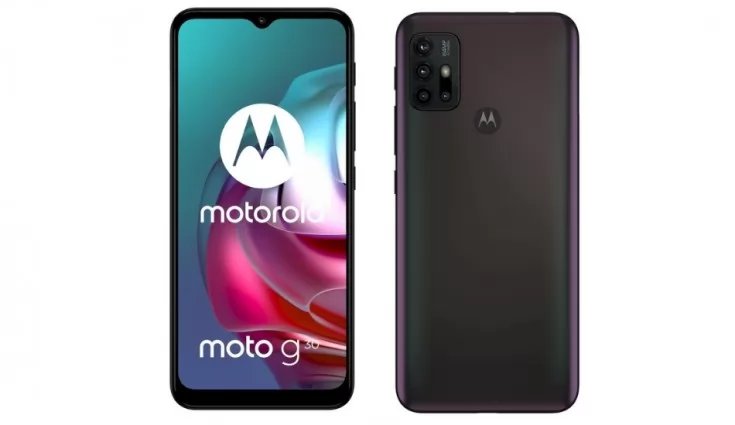
The Moto G10 Power is priced at Rs 9,999 while the Moto G30 is priced at Rs 10,999. They are budget smartphones but spending 1k more on Redmi Note 10 will be a better option owing to better display, better processor and more battery. Also, Redmi Note 10 is upgradeable to MIUI 12.5.
Moto G30 sports a 6.5-inch HD+ IPS display with a resolution of 1600 x 720 pixels, 20:9 aspect ratio and 90Hz refresh rate. It is powered by the Snapdragon 662 SoC paired with 4GB of RAM and 64GB of storage with support for expandable storage up to 1TB using a microSD card.
The quad-camera setup on the back consists of a 64MP primary sensor, 8MP ultra-wide angle sensor along with 2MP depth sensor and a 2MP macro camera. Moto G30 has a 13-megapixel camera sensor at the front. The Moto G30 is backed by a 5,000mAh battery with 20W fast charging support. It is claimed to deliver up to two days of usage on a single charge.
Moto G10 Power features a 6.5-inch Max Vision HD+ display with a 60Hz refresh rate. The phone is powered by the Snapdragon 460 SoC paired with 4GB RAM, and 64GB of storage. Moto G10 Power packs a 6,000mAh battery that can deliver over two days of usage on a single charge.
The quad-camera setup on the back features a 48-megapixel f/1.7 main sensor, 8-megapixel ultra-wide-angle sensor, and two additional 2-megapixel macro and depth sensors. There is also an 8-megapixel selfie camera sensor at the front.
Moto G30 Pros
Android 11 with a near stock interface
Decent Cameras
Moto G30 Cons
Average Chipset


